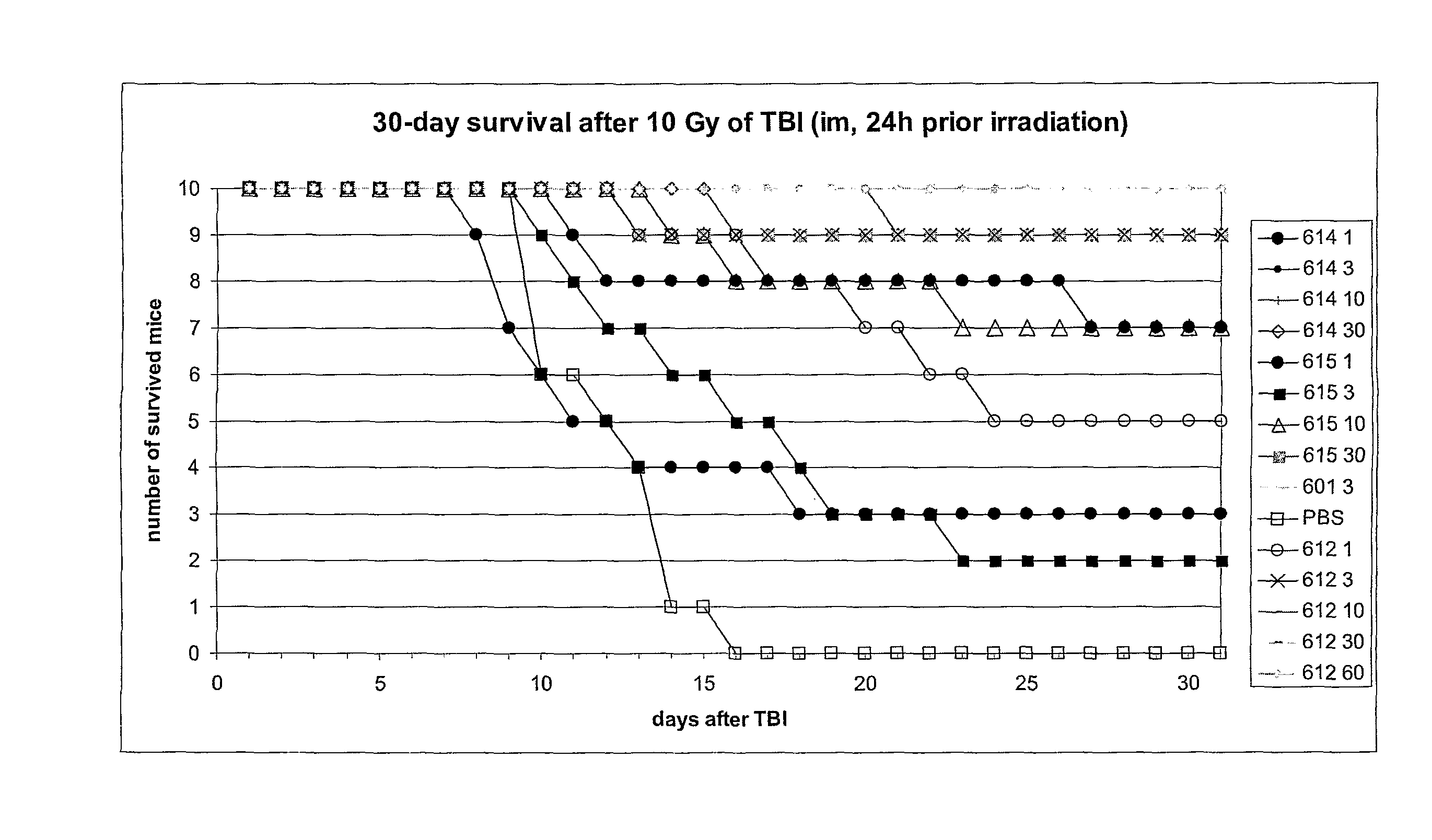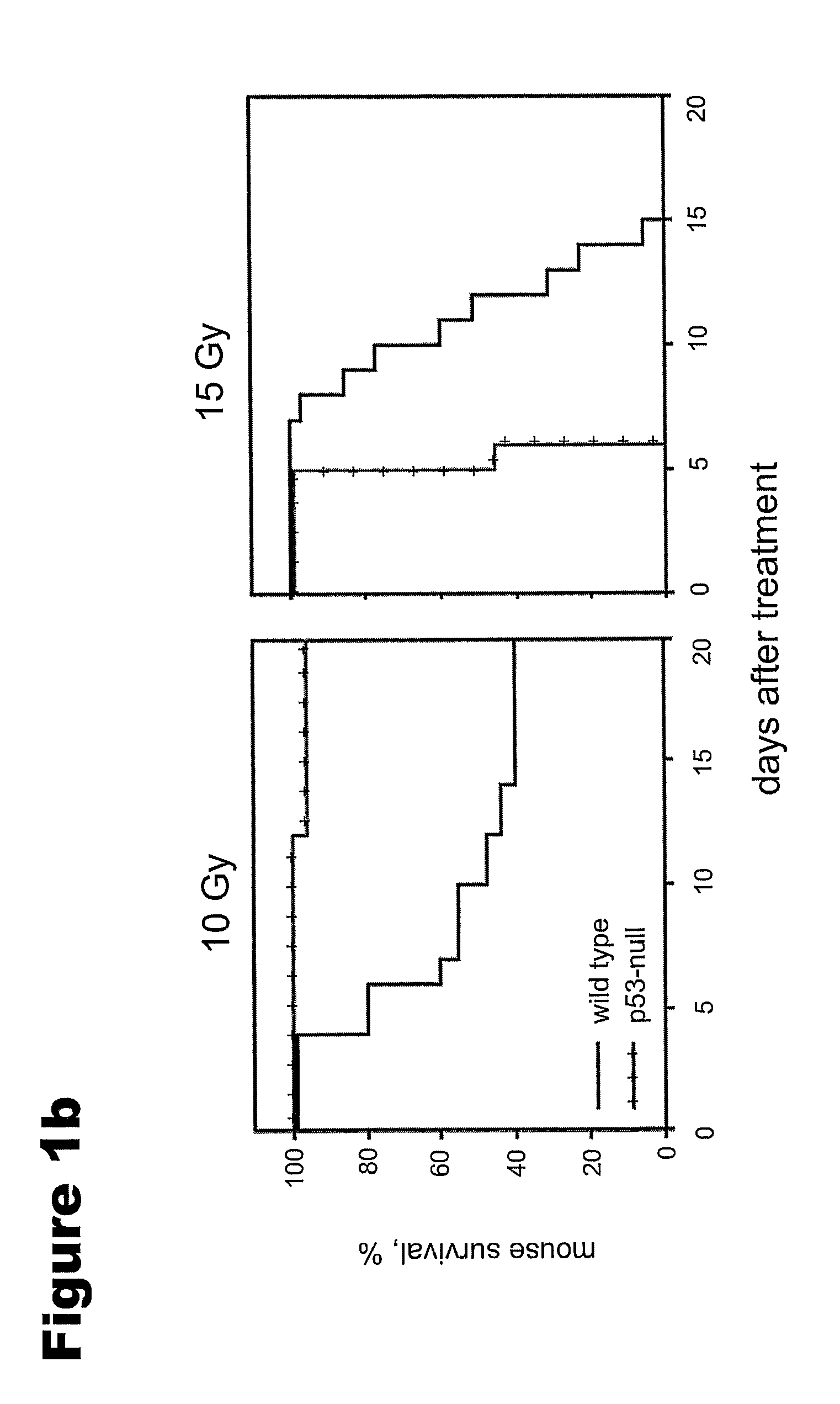Methods of protecting against apoptosis using lipopeptides
a technology of lipopeptides and apoptosis, which is applied in the direction of anti-noxious agents, peptide/protein ingredients, drug compositions, etc., can solve the problems of complex natural sensitivity of such tissues, risky normal rapid dividing or apoptosis-prone tissues, and well-known side effects
- Summary
- Abstract
- Description
- Claims
- Application Information
AI Technical Summary
Benefits of technology
Problems solved by technology
Method used
Image
Examples
example 1
p53 Deficiency Accelerates Development of the GI Syndrome in Mice
[0124]The primary cause of death from ionizing radiation (IR) of mammals depends on the radiation dose. At doses of up to 9-10 Gy, mice die 12-20 days later, primarily from lethal bone marrow depletion, i.e., the hematopoietic (HP) syndrome. At this dose, irradiated mice can be rescued from lethality by bone marrow transplantation. Animals that received >13-15 Gy die between 7-12 days after treatment (before hematopoietic syndrome could kill them) from complications of damage to the small intestine, i.e., the gastrointestinal (GI) syndrome. It is well known that cell proliferation of the epithelial cells of the small intestine is limited to the crypts where stem cells and early proliferating progenitors are located. After a couple of cell divisions, already differentiated descendants of crypt stem cells move up the villi to be shed at the villar tip. In the small intestine of the mouse, the entire “trip” of the cell (i...
example 2
Lipopeptides Delay Mouse Death Caused by Total Body Gamma-Irradiation
[0131]Lipopeptides are potent activators of NF-κB and, as such, may act as inhibitors of apoptotic death. To determine whether lipopeptides function as radioprotectants, various lipopeptides were initially tested to determine the maximal tolerable dose (MTD). Various lipopeptides were then tested to measure their protective effect in NIH Swiss mice to lethal hematopoietic or nd gastrointestinal syndromes after exposure to 10 Gy or 13-15 Gy of total body gamma radiation, respectively. Lipopeptides (0.3-10 μg / mouse) were administered subcutaneously 30 minutes prior to irradiation. Lipopeptides tested that provided radioprotection are set forth in Table 3.
[0132]
TABLE 3SEQ IDPeptidePeptide SequenceNOLengthN-acylationSKKKK 8 5R-Pam2SKKKK 8 5R-Pam3FEPPPATTT22 9Pam2GNNDESNISFKEK3113Pam2GDPKHPKSF24 9Pam2GETDKEGKIIRIFDNSF3717Pam2
[0133]The results of a representative experiment using R-PAM2C-SKKKK (SEQ ID NO: 8) (hereafter, ...
example 3
Radioprotective Efficacy of a Single Dose of CBLB601 Against Total Body Gamma-Irradiation
[0134]CBLB601, a R-Pam2-lipopeptide with the peptide moiety consisting of C-SKKKK (SEQ ID NO: 8), was selected for more detailed characterization as a radioprotector based upon its ability to activate NF-κB and preliminary in vivo data on radioprotection in NIH-SWISS mice (see Example 2). The objectives of this study were to determine the optimal dose, route of administration, and time of administration of CBLB601 to serve as a protector. ICR female mice of 10-15 weeks of age were used, with 10-15 animals per group or condition.
[0135]The dose of NOAEL (No Obvious Adverse Effects Level) was determined by injecting intraperitoneally (i.p) ICR mice with the increasing doses of CBLB601 (0.3, 1, 3, 10, 30, 60, 100 μg / mouse). Control mice were injected with PBS. The mice were observed for two weeks. During the first week they were weighed daily. There were no differences in weight between the CBLB601-...
PUM
| Property | Measurement | Unit |
|---|---|---|
| time points | aaaaa | aaaaa |
| weight | aaaaa | aaaaa |
| molecular weights | aaaaa | aaaaa |
Abstract
Description
Claims
Application Information
 Login to View More
Login to View More - R&D
- Intellectual Property
- Life Sciences
- Materials
- Tech Scout
- Unparalleled Data Quality
- Higher Quality Content
- 60% Fewer Hallucinations
Browse by: Latest US Patents, China's latest patents, Technical Efficacy Thesaurus, Application Domain, Technology Topic, Popular Technical Reports.
© 2025 PatSnap. All rights reserved.Legal|Privacy policy|Modern Slavery Act Transparency Statement|Sitemap|About US| Contact US: help@patsnap.com



